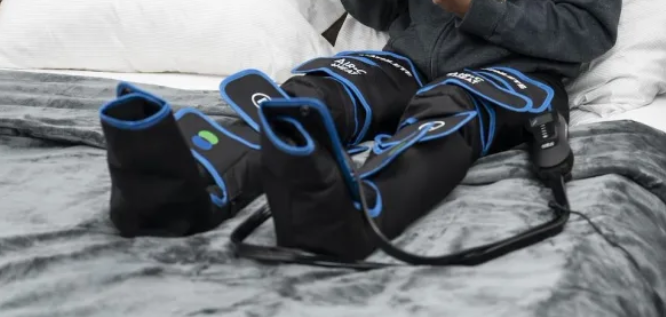
Rethinking Arthritis Treatment with Compression Therapy
Arthritis affects more than 350 million people worldwide, limiting mobility and causing chronic pain
1. While traditional treatments like medication, physical therapy, and lifestyle changes play a vital role, an emerging frontier in arthritis management is compression therapy—a solution often overlooked yet backed by scientific research.
But what if compression therapy did more than just reduce swelling? What if the next generation of smart compression garments could actively monitor inflammation, adapt in real time, and integrate with personalized digital health solutions?
In this forward-thinking guide, we explore not only how compression therapy works today but also where it’s headed next, including AI-driven adaptive compression and 3D-printed joint-specific support systems.
How Compression Therapy Works for Arthritis (Beyond Circulation)
Compression Boots isn’t just about improving circulation—it creates a mechanical and neurological effect that supports joint stability and enhances pain reduction in innovative ways.
1. The Neuro-Mechanical Effect of Compression
When compression is applied, sensory receptors in the skin and deep tissues send signals to the brain, improving proprioception (your body’s sense of movement and position)【2】. This:
✅ Reduces the risk of falls—especially in knee and ankle arthritis.
✅ Helps muscles contract more efficiently, decreasing joint strain.
2. Compression as an Inflammation Regulator
New research suggests compression garments influence the body’s inflammatory response by:
Reducing inflammatory cytokines, chemicals responsible for joint pain【3】.
Modulating lymphatic drainage, preventing excessive swelling.
Regulating joint fluid pressure, which may slow cartilage degradation【4】.
3. Compression’s Role in Joint Stabilization & Pain Perception
- External compression acts as an “exoskeleton,” absorbing joint impact forces—a major benefit for those with osteoarthritis【5】.
- It dampens pain signals by interacting with nociceptors (pain-sensitive nerve endings), leading to a phenomenon called “gate control”—where non-painful stimuli (pressure) override pain signals【6】.
Key Insight: Compression therapy isn’t just about improving circulation—it restructures the way the body experiences arthritis pain.
Choosing the Right Compression Garment for Maximum Impact
1. Matching Compression to Arthritis Type (Beyond Basics)
| Arthritis Type | Recommended Compression Garment | Why It Works |
|---|---|---|
| Osteoarthritis (OA) | Knee sleeves, full-leg compression stockings | Supports weakened joint cartilage, reduces weight-bearing pain. |
| Rheumatoid Arthritis (RA) | Compression gloves, ankle sleeves | Reduces inflammation in smaller joints, regulates immune response. |
| Psoriatic Arthritis | Full-leg compression with skin-sensitive fabric | Combats systemic inflammation while minimizing skin irritation. |
| Post-Surgical or Severe Arthritis | Firm (30-40 mmHg) compression wraps | Limits excessive swelling post-knee replacement or severe flare-ups. |
Pro Tip: If your arthritis is localized, opt for targeted compression sleeves. If systemic, full-leg compression is more effective.
2. The Role of Compression Levels in Therapy
Compression machine isn’t one-size-fits-all. The correct pressure depends on pain levels, swelling severity, and activity type.
- Light (10-15 mmHg): Ideal for mild arthritis, everyday use.
- Moderate (15-30 mmHg): Best for reducing pain & swelling while staying active.
- Firm (30-40 mmHg): For severe arthritis or post-surgical support (requires medical approval).
Key Insight: The future of compression therapy lies in garments that dynamically adjust their pressure based on inflammation levels in real-time.
Implementing Compression Therapy: A Smart Approach
Step 1: Consult a healthcare provider to determine the right compression level and type.
Step 2: Start with a gradual wear schedule to prevent discomfort.
| Week | Recommended Wear Time |
|---|---|
| Week 1 | 2-3 hours per day |
| Week 2 | 4-6 hours per day |
| Week 3 | 6-8 hours per day |
| Week 4+ | All-day wear (as needed) |
Step 3: Track pain, swelling, and mobility improvements using a journal or arthritis tracking app.
The Future of Compression Therapy: What’s Next?
1. AI-Powered Adaptive Compression (Real-Time Adjustments)
Wearable compression sleeves with embedded biosensors will automatically adjust pressure based on joint swelling and inflammation markers【7】.
AI algorithms will analyze patient movement and deliver personalized compression patterns for maximum pain relief.
Potential Breakthrough: AI-driven compression therapy could eliminate the need for trial-and-error in choosing the right garment by adapting in real time to patient needs.
2. 3D-Printed, Patient-Specific Compression Gear
Future compression garments will be 3D-printed using biometric data from MRI scans, ensuring a perfect anatomical fit.
This will be game-changing for severe arthritis patients, offering joint-targeted support beyond generic compression sleeves.
Key Insight: Imagine a compression sleeve designed for your exact knee structure, tailored for your pain points—this will soon be a reality.
3. Compression with Integrated Pain Management
Researchers are developing compression machines infused with pain-relief nanotechnology, allowing slow-release anti-inflammatory medication to be delivered directly through the skin【8】.
Some prototypes combine heat therapy with compression, optimizing blood flow while reducing stiffness.
Future Projection: These “smart compression garments” will likely become a core component of personalized arthritis treatment plans, integrating seamlessly with telehealth monitoring systems.
Final Takeaways: Why Compression Therapy Is a Must-Try for Arthritis
✅ Compression therapy reduces inflammation, improves joint stability, and enhances pain relief.
✅ The mechanical + neurological benefits go beyond circulation—compression changes how pain is perceived.
✅ The future of compression therapy is AI-driven, 3D-customized, and medication-enhanced.
✅ Start with the right compression level and track your progress—future solutions will automate this process.